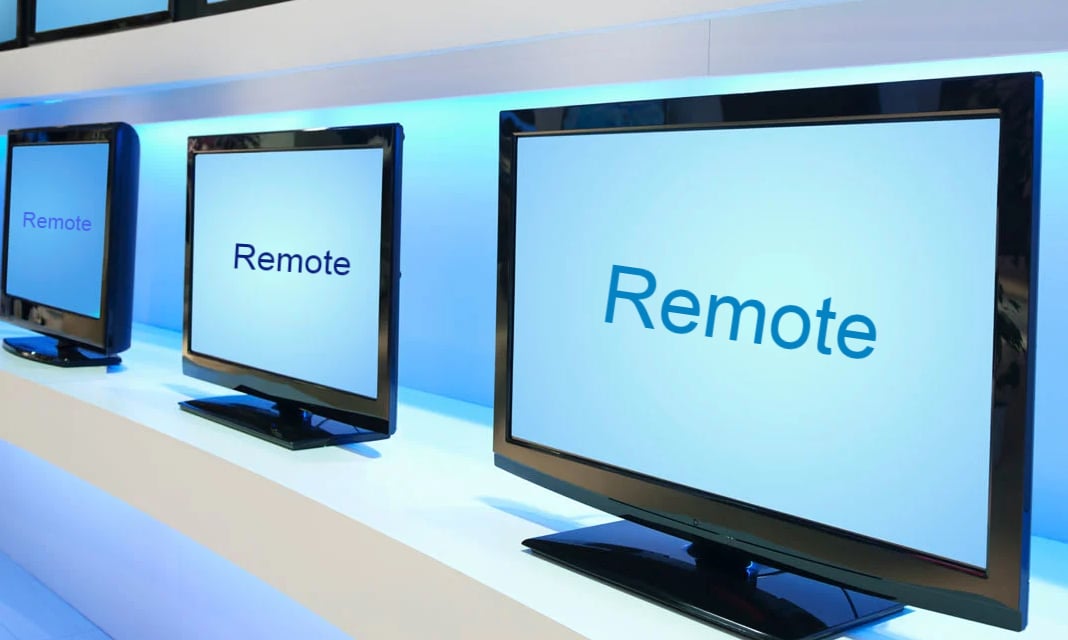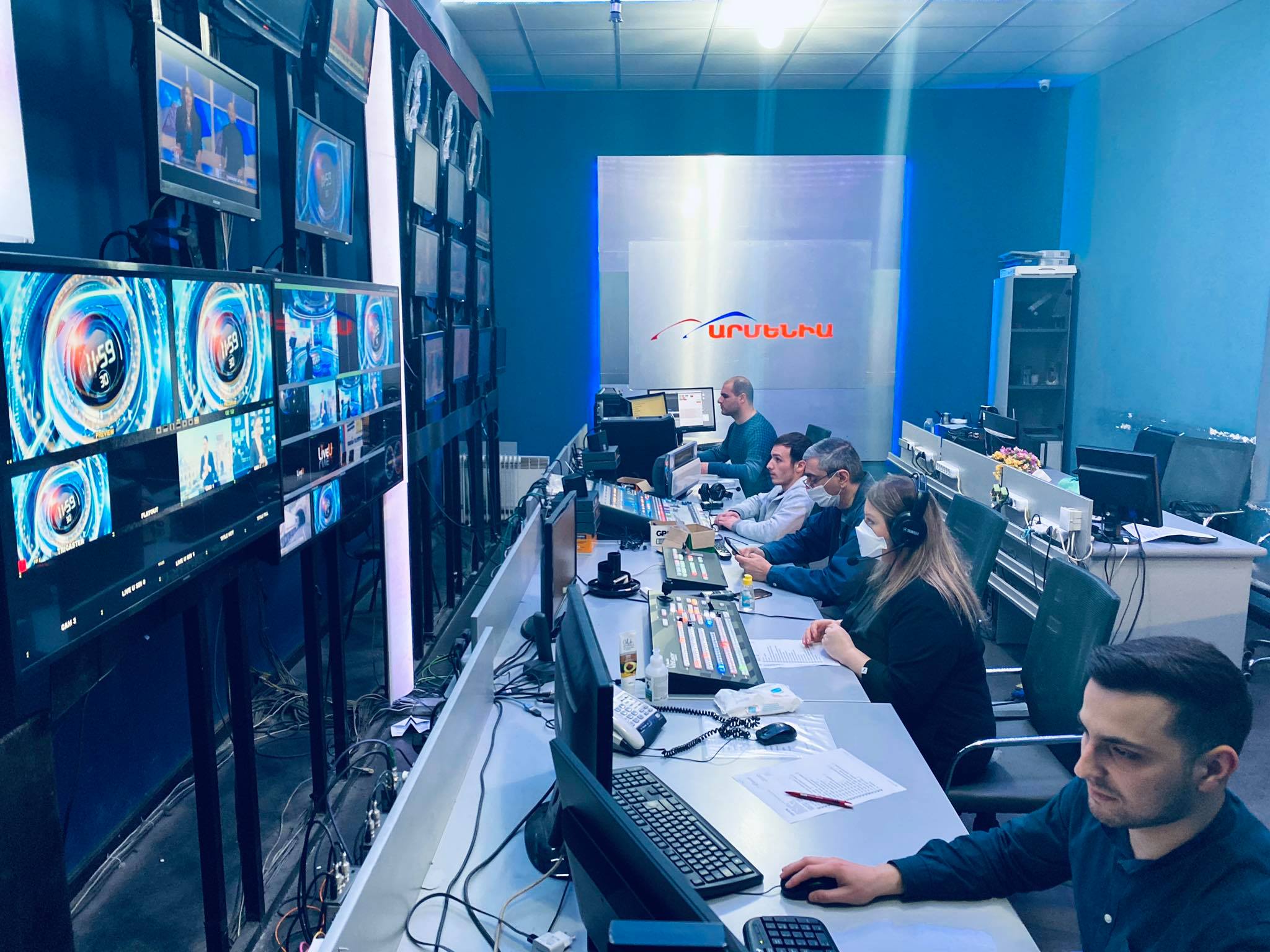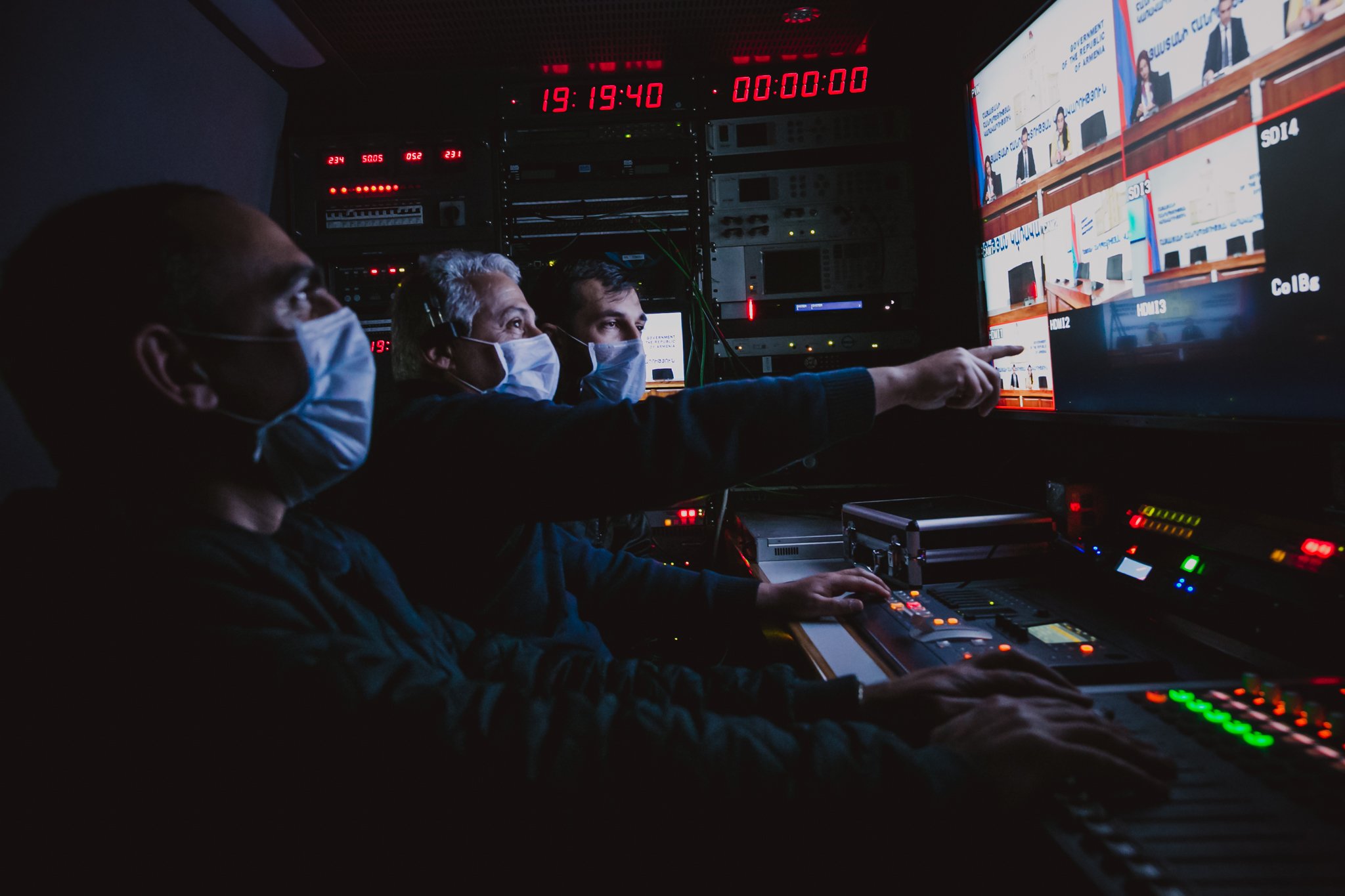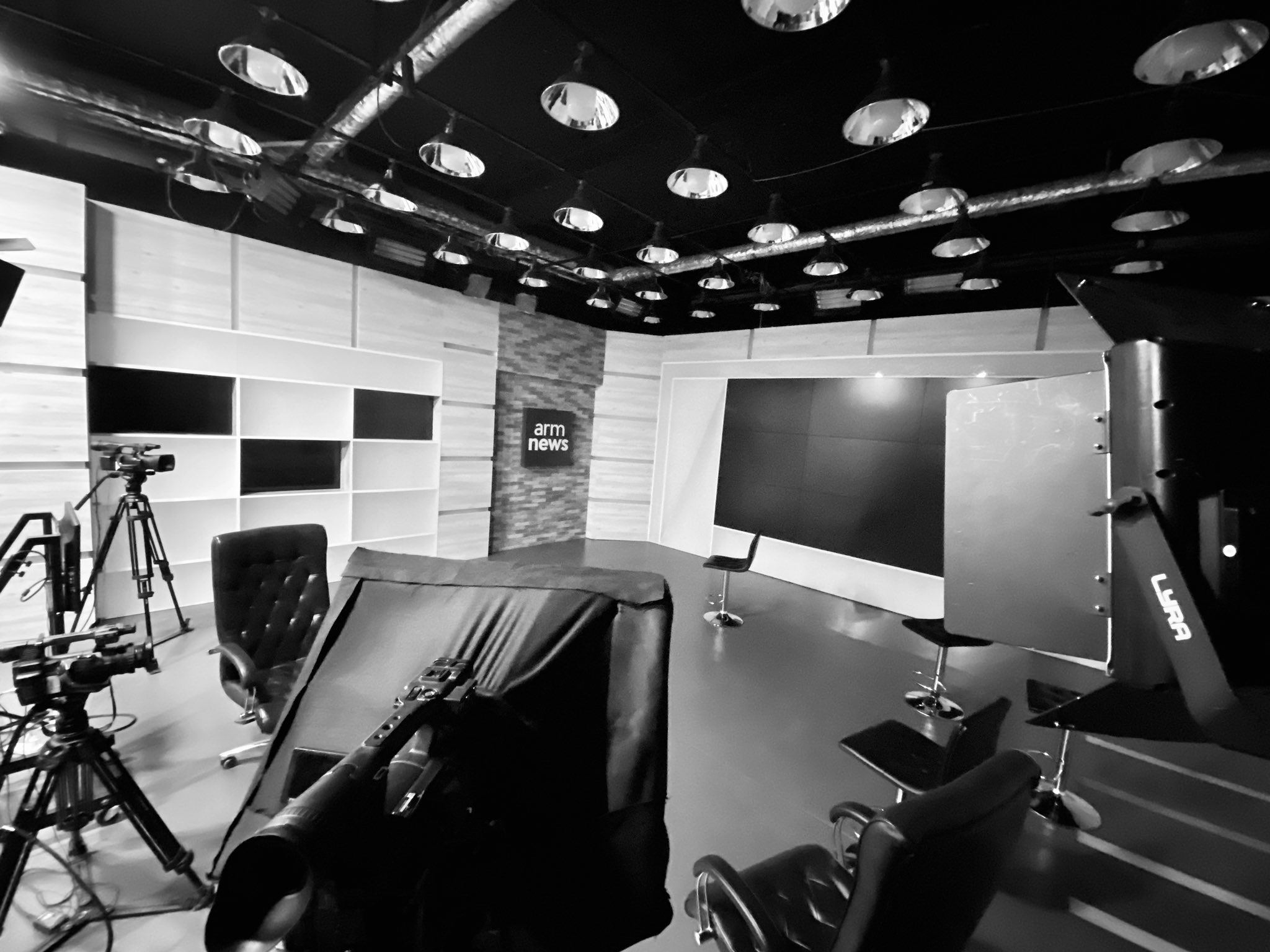
Coronavirus and the state of emergency have changed the working style and contents of TV companies.
Lockdown conditions have made it difficult for TV companies to find guests and invite them to the studios. Producing talk shows, various programs, in-house TV series has become impossible.
It’s equally hard to organize location shooting outside the studios. TV companies have minimized them.
TV contents have also changed, the main topic being COVID-19 and the situation around it.
All of this has quickly made TV companies switch to remote working and use online platforms and tools.
Armenia

In this period, Armenia TV company has more live broadcasts from the commandant’s office, the government sessions and the National Assembly.
Gnel Nalbandyan, the editor-in-chief of the TV company’s news department, says that they have significantly reduced the amount of location shootings. Regional and Artsakh-based correspondents keep producing stories but their total number has decreased.
“It has become difficult to get in touch with officials. Usually, you cannot find them in their workplaces, and we try to have phone interviews. Also, we frequently use their social media posts,” he says.
Armenia has started implementing a new format in the situation caused by Coronavirus, “Our fellow Armenians living abroad film little stand-ups in their places of residence, present the situation, talk about problems and their solutions. Every day, we have a few such stories from various parts of the world.”
The TV company regularly tries to report about the isolated citizens by contacting them, conducting interviews and making stories with the help of video pieces sent by them. Meanwhile, the company strictly maintains personal data confidentiality.
One of the stories was produced by a girl in a 14-day quarantine at a Tsaghkadzor hotel. The press secretary of the Ministry of Defense produced a piece about isolated soldiers but their faces were blurred in the broadcast story because they had been filmed without their consent.
Online interviews have become an essential part of television broadcasting. Formerly, online broadcasts were not being used because of the poor quality of picture and voice. However, they have to do it now, as Gnel Nalbandyan says, “We don’t have any other choice – we even use the shots of officials going live.”
In these conditions Armenia tries to inform the audience about the events happening in Armenia and worldwide, as much as possible.
“Unfortunately, about 70 or 80 percent of our broadcasts is about Coronavirus – that’s how all of our newscasts begin. We don’t have a sports bloc anymore because there are no sports events. Of course, the weather forecast remains unchanged.”
The company has also stopped the in-house TV series production. However, that airtime should be replace with some other production. That’s another complicated problem that TV companies have faced, Nalbandyan says.
Public TV

Starting from the first day of the state of emergency, Public TV switched to an emergency mode, and the program schedule changed.
Public TV was the first one to broadcast distant lessons. There are more shows for kids and youth, as well as television films and movies.
“A new studio was made literally in one day at our TV company,” says Tigran Danielyan, the Public TV PR and External Relations Director.
The First Channel news service schedule is unusually busy now – live broadcasts once in two hours, as well as government members’ press conferences.
The Public TV team organizes all the live broadcasts of the Armenian Unified Information Center, providing the other media with a chance to rebroadcast them through an open channel.
As soon as a state of emergency was declared, the TV company suspended almost all the studio and location shootings.
At this time only the news service employees conduct location shootings.
Tigran Danielyan says that sometimes there are some difficulties in conducting the interviews – in some cases the reporters take advantage of modern technologies to conduct remote interviews.
Still, the First Channel has maintained the live project Early in the Morning. The airtime has been reduced a little bit but the program contains a bigger informational and educational component.
The program Time will Tell was back on the air on March 30. The four hosts are in a self-isolation. However, they discuss various issues four times a week, hosting their guests on an online platform and answering the viewers’ questions.
“Emergency” (or “Extraordinary”) Concert is a new project of Public TV, broadcast from Monday to Friday.
All the used areas of the TV company are disinfected before each shooting. The shooting crew and the participants of the concert are provided with the necessary disinfectants. The shootings are preceded by a medical examination and a temperature-taking. Obviously, there is no audience at the concerts, and there are no more than 15 people working in the studio.
These days, a significant part of the TV staff works from home.
Both the newscast journalists and the company managers work in a daily emergency mode, organizing uninterrupted broadcasting.
Most program crews try to introduce online tools into their work process, remotely organizing the production and broadcast of their shows.
Many specialists work from home, using online instruments to find graphical and video editing solutions to be used in broadcasting.
The employees of the broadcasting department continue their work around the clock.
The company team does everything to provide the public with timely and high-quality information and programs.
Armnews

“If you turn on Armnews right now, it will take you 7 minutes at most to get updated news on Coronavirus – that’s what we tried to achieve in the first place,” says Narek Nikoghosyan, the head of Armnews TV company.
He says that they immediately changed the blue color of their screen ticker into red. The Brief News headline was changed into Coronavirus.
As soon as the Prime Minister declared a state of emergency, the words STAY HOME appeared on their logo.
“As for the contents, we significantly added more Coronavirus-related live broadcasts, interviews, discussions and analyses. We also tried to demonstrate the current mood existing in Armenia and foreign countries through updated photos and videos,” Narek Nikoghosyan says.
Coronavirus and the state of emergency made them almost completely switch to remote work within a few days. They hardly had any technical issues,
“Fortunately, new technologies allow to fully organize broadcasting from home. If you manage to ensure information security, you will eventually get accustomed to it. Our team promptly solved these issues and I have a feeling that we got used to the new workstyle.”
The TV companies face a dilemma – to satisfy the increasing news consumption demands of the audience, or to ensure the employees’ and guests’ health safety.
“Of course, there was some discomfort but we quickly got used to the nuances of working online, just like most people in today’s world. As a result, we switched to remote work but the contents, the work quality and the employees were not affected at all. We just minimized the location shootings – the main work is done from home,” the head of the TV company says.
Nikoghosyan states that the doors of their studios are closed. In the first days a large part of the guests could not quite handle the internet tools. However, the producers of Armnews were quickly getting in touch with the guests and helping them to contact the interviewer on an online platform. There are no problems related to interview organizing at this moment.
All the stay-at-home reporters have online communication with the editor. They produce their stories with the help of computers, by shooting and recording all the components at home and sending the audiovisual content to stay-at-home sound guys and video editors. They, in their turn, send the final product to the broadcast department.
“In the long run, only the employees of the Armnews broadcast department operate from the workplace. Surely, it would be possible to organize it remotely, too. However, you are not encouraged to do that, based on the television security rules. You might say that these people get self-isolated in their offices, due to their work schedule,” Narek Nikoghosyan says.
Anahit Danielyan


Add new comment
Comments by Media.am readers become public after moderation. We urge our readers not to leave anonymous comments. It’s always nice to know with whom one is speaking.
We do not publish comments that contain profanities, non-normative lexicon, personal attacks or threats. We do not publish comments that spread hate.